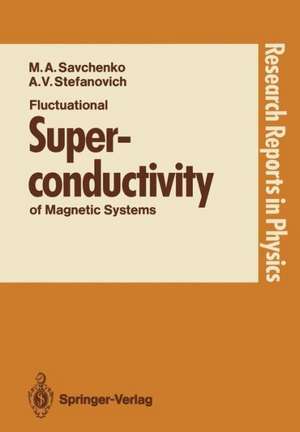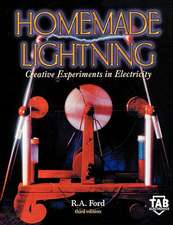Fluctuational Superconductivity of Magnetic Systems: Research Reports in Physics
Autor Maxim A. Savchenko Traducere de Ram S. Wadhwa Autor Alexei V. Stefanovich Traducere de Natalie Wadhwaen Limba Engleză Paperback – 17 mai 1990
Din seria Research Reports in Physics
- 15%
 Preț: 643.48 lei
Preț: 643.48 lei - 15%
 Preț: 650.37 lei
Preț: 650.37 lei - 15%
 Preț: 642.18 lei
Preț: 642.18 lei - 15%
 Preț: 646.30 lei
Preț: 646.30 lei - 15%
 Preț: 645.14 lei
Preț: 645.14 lei - 15%
 Preț: 634.68 lei
Preț: 634.68 lei - 15%
 Preț: 638.43 lei
Preț: 638.43 lei - 15%
 Preț: 634.00 lei
Preț: 634.00 lei - 15%
 Preț: 638.76 lei
Preț: 638.76 lei - 15%
 Preț: 642.36 lei
Preț: 642.36 lei - 15%
 Preț: 640.06 lei
Preț: 640.06 lei - 15%
 Preț: 636.80 lei
Preț: 636.80 lei - 15%
 Preț: 640.24 lei
Preț: 640.24 lei - 15%
 Preț: 640.37 lei
Preț: 640.37 lei - 15%
 Preț: 642.83 lei
Preț: 642.83 lei - 15%
 Preț: 633.35 lei
Preț: 633.35 lei - 15%
 Preț: 634.68 lei
Preț: 634.68 lei - 15%
 Preț: 632.70 lei
Preț: 632.70 lei - 15%
 Preț: 646.62 lei
Preț: 646.62 lei - 15%
 Preț: 635.96 lei
Preț: 635.96 lei -
 Preț: 380.07 lei
Preț: 380.07 lei -
 Preț: 385.84 lei
Preț: 385.84 lei -
 Preț: 539.31 lei
Preț: 539.31 lei - 15%
 Preț: 636.80 lei
Preț: 636.80 lei - 15%
 Preț: 632.22 lei
Preț: 632.22 lei
Preț: 388.90 lei
Nou
Puncte Express: 583
Preț estimativ în valută:
74.42€ • 78.05$ • 61.95£
74.42€ • 78.05$ • 61.95£
Carte tipărită la comandă
Livrare economică 01-15 aprilie
Preluare comenzi: 021 569.72.76
Specificații
ISBN-13: 9783540505617
ISBN-10: 354050561X
Pagini: 272
Ilustrații: IX, 258 p. 1 illus.
Dimensiuni: 170 x 242 x 14 mm
Greutate: 0.44 kg
Ediția:1990
Editura: Springer Berlin, Heidelberg
Colecția Springer
Seria Research Reports in Physics
Locul publicării:Berlin, Heidelberg, Germany
ISBN-10: 354050561X
Pagini: 272
Ilustrații: IX, 258 p. 1 illus.
Dimensiuni: 170 x 242 x 14 mm
Greutate: 0.44 kg
Ediția:1990
Editura: Springer Berlin, Heidelberg
Colecția Springer
Seria Research Reports in Physics
Locul publicării:Berlin, Heidelberg, Germany
Public țintă
ResearchCuprins
1. Introduction.- 2. Exchange Enhancement Effect During Phase Transitions in Magnetically Ordered Crystals.- 2.1 Phase Transition in a Ferromagnet with Quadrupole Interaction.- 2.2 Phase Transition in an Antiferromagnet in a Strong Magnetic Field.- 2.3 Fluctuations and Spin Waves in Ferroelectro-antiferromagnets in a Strong Magnetic Field.- 2.4 Phase Transition in a Crystal with Dislocations in a Strong Magnetic Field.- 3. Phase Lamination and the Exchange Enhancement Effect.- 3.1 Phase Transitions in Complex Magnetic Structures and the Exchange Enhancement Effect in Spin-Orbit Interaction.- 3.2 Phase Diagrams of Complex Magnetic Structures: Phase Lamination.- 3.3 Phase Transitions in Ferroelectro-antiferromagnets.- 4. Superconducting Phases in Rare-Earth Metal Compounds: Phenomenological Theory.- 4.1 Superconducting Compounds of Rare-Earth Metals: Formulation of the Problem.- 4.2 Fluctuation Free Energy: Renormalization Group Equations.- 4.3 Phase Diagram of the Superconducting Compounds of Rare-Earth Metals.- 4.4 Topological Analysis of the Phase Diagram of Superconducting Compounds of Rare-Earth Metals.- 5. Theory of High-Temperature Superconducting Phases in Rare-Earth Metal Compounds.- 5.1 Lagrangian of the System near the Point of Phase Transition to Superconducting State.- 5.2 Electron-Phonon Interaction Parameter for the High-Temperature Superconducting Phase.- 6. Solitons in the Theory of Superconductivity of Magnetic Systems.- 6.1 Generalized Order Parameter in Magnetic Superconductors: Equations for the Superconducting Phase.- 6.2 Soliton Mechanism for Emergence of Superconductivity Accompanying a Phase Transition from Superconducting to Paramagnetic States.- 6.3 Solitons in an Inhomogeneous Superconducting State and Topology.- 6.4 Solitons in the Phase of Coexistence of Superconductivity and Magnetism.- 7. Spin Glasses Based on Rare-Earth Metal Compounds.- 7.1 Phase Transitions in Heavy Rare-Earth Metals.- 7.2 Modern Spin Glass Models.- 7.3 Peculiarities of Vector Fields in Heavy Rare-Earth Metals.- 7.4 Magnetic Susceptibility in the New Spin Glasses.- 7.5 Superconducting Phases in Spin Glasses.- 7.6 Peculiarities of Spin-Wave Dynamics in Spin Glasses.- 8. High-Temperature Superconducting Ceramics.- 8.1 High-Temperature Superconducting Oxides.- 8.2 Spectrum of Quasi-Particles Exchanged by Electrons in HTS Ceramics.- 8.3 Possibility of Increasing the Critical Temperature: Properties of High-Temperature Superconductors.- 9. Theory of High-Temperature Superconductivity of Ceramic Systems.- 9.1 Microscopic Equations for the Superconducting Phase.- 9.2 Separation of Many-Particle Averages in the Superconducting Phase Equations: Wick’s Theorem.- 9.3 Electron-Phonon Interaction in Superconducting Phases: Superconducting Transition Temperature.- 9.4 Phase Lamination in Superconducting States.- 9.5 Microscopic Equations near the Phase Transition Point: Relation to the Phenomenological Theory.- 10. Theory of High-Temperature Superconductivity of Polymer Systems.- 10.1 Quasi-One-Dimensional Organic Superconductors: Polyacetylene as a Possible Superconductor.- 10.2 Criterion for the Emergence of Superconductivity in Polyacetylene.- 10.3 High-Frequency Properties of Polyacetylene in the Nonsuperconducting State.- References.






